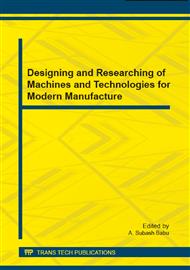[1]
Müller HK. Concepts of sealing mechanism of rubber lip type rotary shaft seal. Proceedings of 11th international conference on fluid sealing, BHRA, 1987, pp.698-709.
Google Scholar
[2]
Kawahara Y, Hirabayashi H. Effect of surface condition of lip on sealing phenomena of oil seals, (1978).
DOI: 10.4271/780405
Google Scholar
[3]
Horve LA. A macroscopic view of the sealing mechanism for radial lip oil seals. Proceedings of 11th international conference on fluid sealing, BHRA, 1987, pp.710-731.
Google Scholar
[4]
Salant, R. F., Modeling rotary lip seals, Wear, 1997, 207, pp.92-99.
DOI: 10.1016/s0043-1648(96)07463-7
Google Scholar
[5]
Kuzma. D.C. Theory of the mechanism of sealing with application to face seals, Journal of Tribology, 1969, 91, pp.704-712.
DOI: 10.1115/1.3555028
Google Scholar
[6]
Qian, D.S. The sealing mechanism and design factors of radial lip seal for crankshafts, Neiranji Gongsheng, 1984, 5, pp.10-13.
Google Scholar
[7]
Shi, F., and Salant, R.F., A Mixed Soft Elastohydrodynamic Lubrication Model with Interasperity Caviation and Surface Shear Deformation, ASME J. Tribol., 2000, 122, pp.308-316.
DOI: 10.1115/1.555358
Google Scholar
[8]
Shi, F. and Salant, R.F. Numerical study of a rotary lip seal with a quasi-random sealing surface, ASME J. Tribol., 2001, 123, pp.517-524.
DOI: 10.1115/1.1308028
Google Scholar
[9]
Salant, R.F. and Rocke, A.H. Hydrodynamic Analysis of the Flow in a Rotary Lip Seal Using Flow Factors, Tribol. Trans., 2004, 126, pp.156-161.
DOI: 10.1115/1.1609486
Google Scholar
[10]
Yang, A.S., Wen, C.Y., Tseng, C.S. Analysis of flow field around a ribbed helix lip seal, Tribology International, 2009, 42, pp.649-656.
DOI: 10.1016/j.triboint.2008.09.003
Google Scholar
[11]
Patir, N. A numerical procedure for random generation of rough surfaces, 1978, Wear, 47(2), pp.263-277.
DOI: 10.1016/0043-1648(78)90157-6
Google Scholar
[12]
Salant and Dawei. Shen, Deterministic modeling of a rotary lip seal with microasperities on the shaft surface, PHD desertion, Georgia Institution of Technology, (2005).
Google Scholar
[13]
Rocke, A. H. and Salant, R. F. Elastohydrodynamic analysis of a rotary lip seal using flow factors. Tribol. Trans., 2005, 48, pp.308-316.
DOI: 10.1080/05698190590965639
Google Scholar
[14]
Hadinata, P. C. and Stephens, L. S. Soft elastohydrodynamic analysis of radial lip seals with deterministic microasperities on the shaft. Trans. ASME J. Tribol., 2007, 129, pp.851-859.
DOI: 10.1115/1.2768087
Google Scholar
[15]
Timoshenko S., Goodier J.N. Theory of Elastisity, McGraw Hill, (1951).
Google Scholar


